When I started planning my pergola, the first big question I had was about wood. What kind should I use?
I wanted something that looked good, stayed strong in the weather, and didn’t break the bank.
There are so many wood types, each with its own pros and cons.
Some last longer, and some cost less. Others are just easier to work with. If you’re new to building things, this can get a little confusing.
In this blog, I’ll explain the best wood options for a pergola, what makes each one special, and what to consider before you choose.
I’ve kept it easy to read and straight to the point. If you’re planning to build your pergola, this guide will help you pick the right wood with confidence. Let’s get started.
Why the Type of Wood Matters for a Pergola
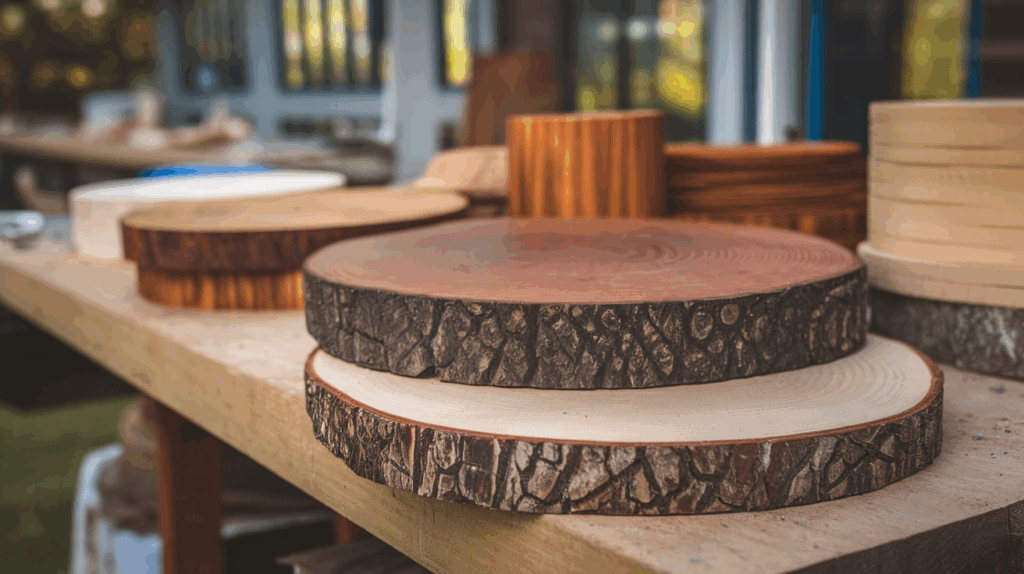
Picking the right wood for your pergola is important because it affects how strong, safe, and long-lasting your structure will be.
Some woods are better at handling weather, while others resist bugs or rot.
For example, cedar and redwood naturally fight off moisture and pests, making them great for outdoor use.
Tropical hardwoods like Ipe are super strong and need little care, but they can be pricey. Softer woods like pine cost less but need more upkeep.
The wood you choose also affects how your pergola looks and how much work you’ll need to keep it in good shape. Some woods need sealing or staining, while others age well on their own.
Your choice also depends on your budget and how long you want your pergola to last. Picking the right wood from the start helps save time, money, and effort down the road.
Things to Think About Before Choosing Wood
Before we look at each wood type, a few things to keep in mind are:
- Weather in Your Area: Some wood handles rain and sun better than others.
- Budget: Some wood types cost more than others.
- Look and Feel: Do you want light or dark wood? Smooth or rough?
- Maintenance: Some wood types need more care than others.
- How Long You Want It to Last: Some woods can last for decades. Others may only last a few years if not sealed well.
Now let’s go over the best wood choices, one by one.
Best Wood Types for Pergolas
There are many types of wood you can use to build a pergola, and each one has its own advantages. Some are strong and last a long time, while others are cheaper and easy to work with.
Picking the right wood depends on your needs, your budget, and where you live.
1. Cedar
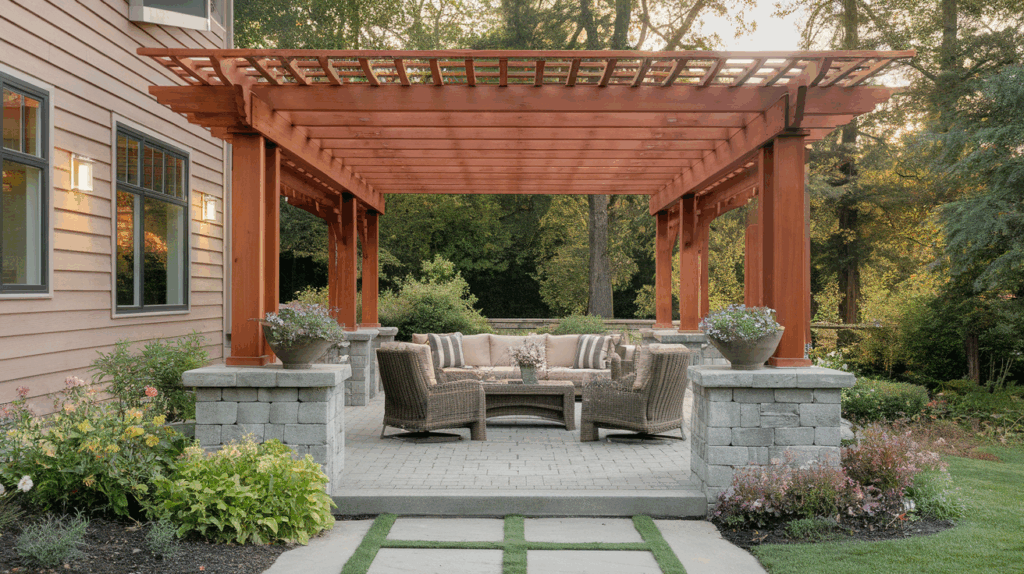
Cedar is a popular choice for pergolas because it looks great and handles outdoor weather well.
It has a warm red tone and smells nice too. Cedar is naturally resistant to rot and bugs, so it lasts longer without a lot of upkeep.
It’s also easy to cut and shape. Over time, it may fade to a gray color unless you seal it. It costs more than pine but less than hardwoods, making it a balanced option for many.
2. Redwood

Redwood is strong, beautiful, and naturally resistant to bugs and rot. It has a rich red tone that many people love. Like cedar, it weathers well but will turn gray if not sealed.
Redwood is soft and easy to work with, but it can be expensive depending on where you live. If you want a pergola that looks fancy and lasts a long time, redwood is a solid pick.
3. Pressure-Treated Wood
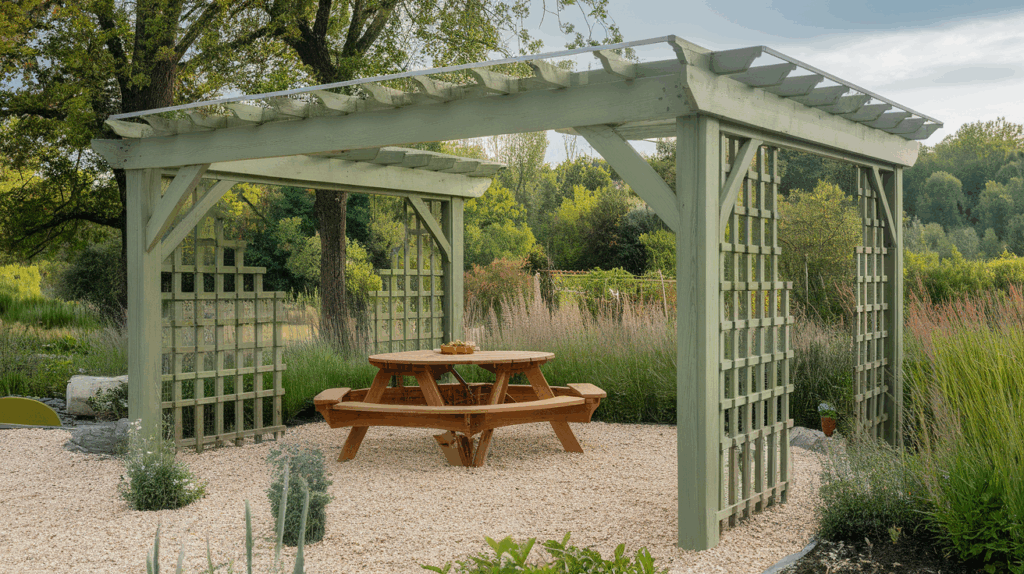
Pressure-treated wood is one of the most affordable options for pergolas. It’s treated with chemicals to keep away rot and insects.
While it’s strong and easy to find, it may look a little green at first. You’ll need to seal it to avoid cracking and warping.
It’s heavier than other woods and may require gloves and a mask when cutting.
It’s a good choice for budget builds if you plan to stain or paint it.
4. Tropical Hardwoods
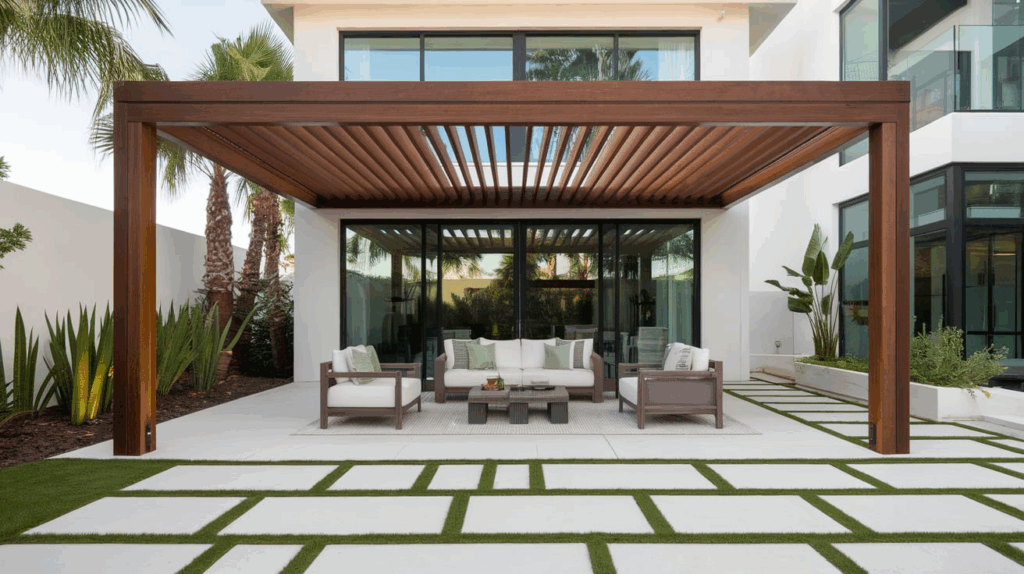
Woods like Ipe, Teak, and Mahogany are known for strength and durability. These hardwoods resist moisture, bugs, and rot naturally. They can last 30 to 50 years with little care.
Their deep colors give a luxury look, but they’re heavy, hard to cut, and more expensive. These woods are best if you want something that looks high-end and lasts a very long time.
5. Douglas Fir

Douglas Fir is a sturdy and budget-friendly softwood. It’s strong and widely used in building.
It has a warm, straight grain that looks good with stain. But it doesn’t resist rot or bugs well on its own, so sealing is a must.
It’s a smart pick if you want something affordable and don’t mind doing a little extra work to protect it.
6. Cypress
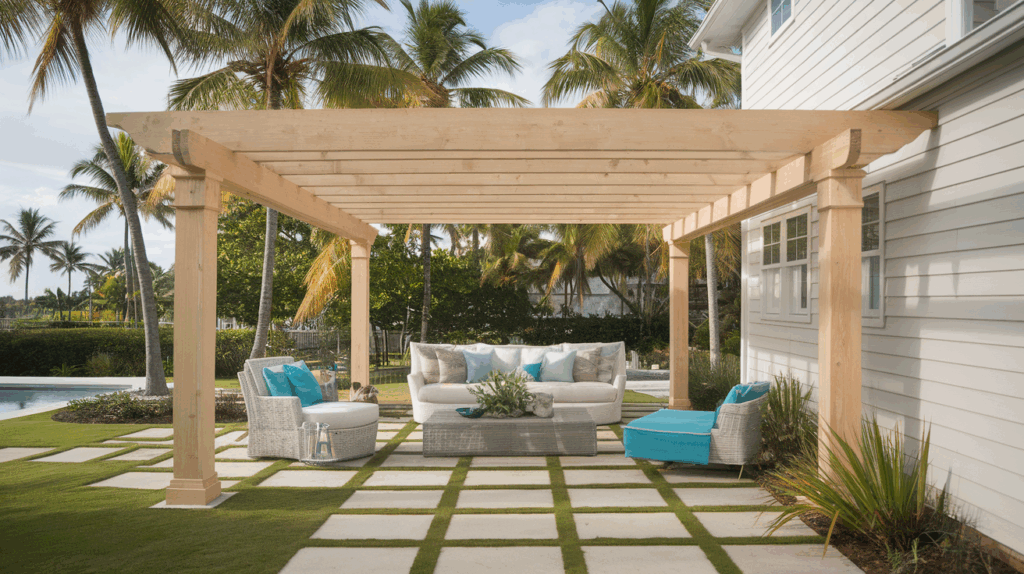
Cypress has natural oils that help it resist rot and bugs. It’s light in color and smells nice. It works well in humid or wet areas and is easy to cut and shape.
Cypress may be harder to find in some places, and like cedar and redwood, it can fade if not sealed. It’s a good middle-ground option for moisture-heavy climates.
7. Spruce, Pine, and Fir (SPF)
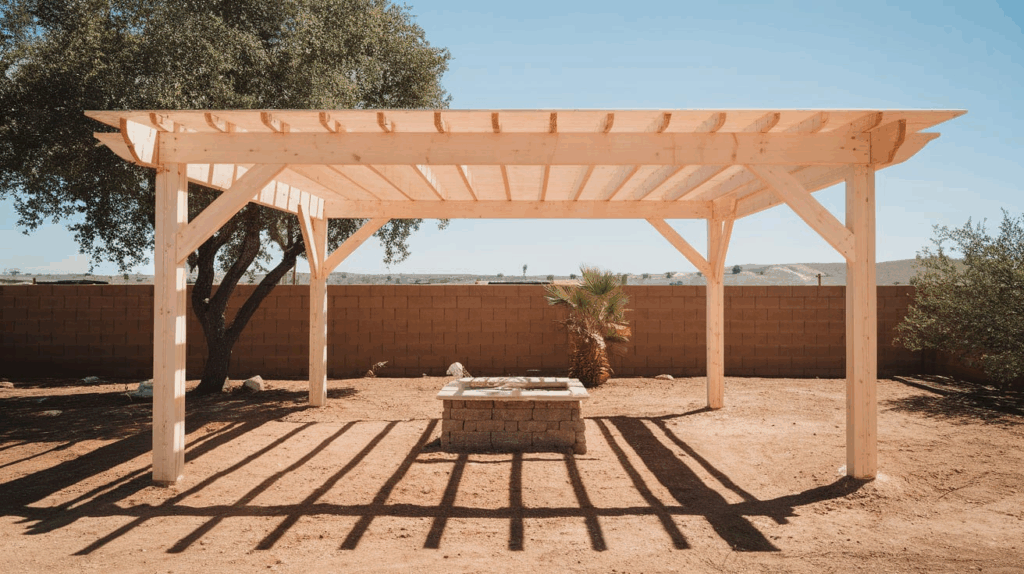
SPF woods are low-cost and easy to find, making them common in home projects. They need sealing or paint right away because they don’t resist moisture or pests well.
Without care, they can warp, crack, or rot quickly. SPF is best for dry areas or short-term use if you’re on a tight budget.
8. Hemlock
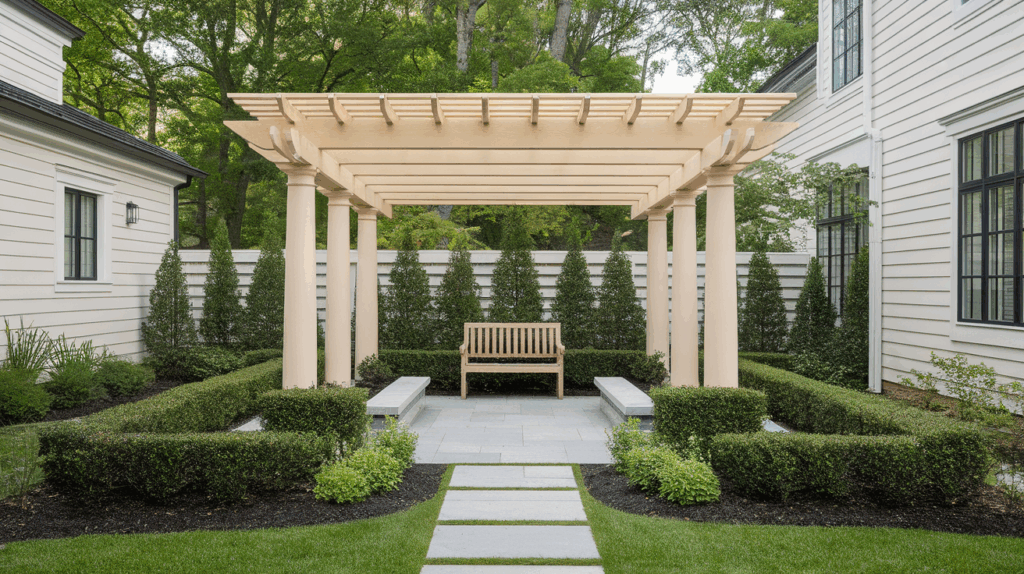
Hemlock is a lighter wood with a clean, smooth look. It’s easy to work with and less expensive than premium woods. But it’s not naturally resistant to bugs or rot, so it needs sealing for outdoor use.
It’s a decent option for dry areas if you want a pale wood that you can treat and maintain.
Comparing the Wood Options Side-by-Side
With so many wood types to choose from, it helps to see how they compare. This quick chart makes it easy to compare each option side by side.
You can check the cost, strength, bug resistance, look, and how much care each one needs. This way, you can quickly spot which wood best fits your needs.
| Wood Type | Cost | Durability | Bug/Rot Resistance | Looks | Maintenance |
|---|---|---|---|---|---|
| Cedar | Medium | High | High | Reddish | Low |
| Redwood | High | High | High | Red/Brown | Low |
| Pressure-Treated | Low | Medium | High | Green/Tan | Medium |
| Ipe/Teak/Mahogany | Very High | Very High | Very High | Dark/Rich | Low |
| Douglas Fir | Low | Medium | Low | Light Brown | High |
| Cypress | Medium | Medium | Medium/High | Pale Tan | Medium |
| SPF | Very Low | Low | Low | Pale | High |
| Hemlock | Low | Medium | Low | Light Cream | High |
This side-by-side comparison clearly shows each wood’s strengths and costs. Some are strong and low-maintenance, but cost more. Others are more budget-friendly but need extra care.
How to Maintain a Wood Pergola
Taking care of your pergola is the best way to keep it strong and looking good. Most wood pergolas are easy to maintain if you check them once or twice a year.
1. Clean It Once a Year: Dirt, mold, and leaves can build up over time. Use a soft brush and soapy water to clean the wood. You can also use a low-pressure washer for large areas. Make sure it dries completely afterward.
2. Reseal or Restain Every 2–3 Years: If your pergola is stained or sealed, check for faded spots. You may need to apply a fresh coat to protect the wood from the sun and rain. Painted pergolas may need touch-ups sooner if the paint starts to peel or crack.
3. Check for Damage: Look for cracks, splinters, or signs of rot. Catching problems early makes repairs easier and cheaper. If you see any rusty screws or nails, replace them with stainless steel to avoid stains and rust.
4. Keep Plants and Vines in Check: If you have vines or climbing plants, make sure they don’t trap too much moisture against the wood. Trim them back if needed so the pergola can dry out after rain.
5. Watch for Bugs: Even bug-resistant wood should be checked for signs of termites or ants. If you see little holes or soft spots, treat the area or call a pro for help.
Simple Maintenance = Long Life: With just a little care each year, your wood pergola can stay strong and beautiful for many years. Set a reminder on your calendar so you don’t forget these quick upkeep steps.
Conclusion
Building a pergola is a great way to add beauty and shade to your yard. But picking the right wood is one of the most important steps.
Each wood type offers something different. Some woods are strong and last for many years with little care. Others may cost less up front but need more upkeep to stay in good shape.
Think about your weather, your budget, and how much time you want to spend on maintenance.
Cedar and redwood are good all-around choices, and pressure-treated wood is great for saving money.
Tropical hardwoods are strong and long-lasting, but can be harder to work with. No matter which wood you pick, sealing and caring for it the right way makes a big difference.
I always suggest taking your time when choosing. Look at the pros and cons. Ask questions at your local store if you’re not sure.
The better the wood, the longer your pergola will last and the better it will look.

